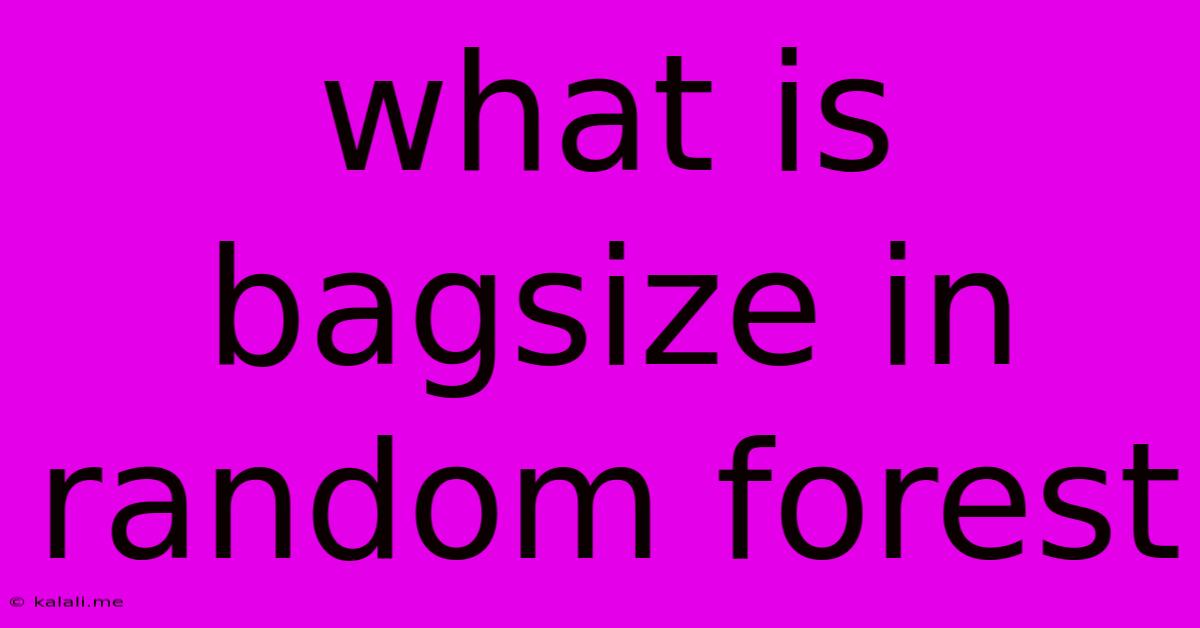What Is Bagsize In Random Forest
Kalali
Jun 06, 2025 · 3 min read

Table of Contents
Understanding Bagging and Bag Size in Random Forests
Random Forests are powerful machine learning algorithms renowned for their accuracy and robustness. At the heart of their effectiveness lies a technique called bagging, or bootstrap aggregating. Understanding bagging, and specifically the concept of bag size, is crucial to effectively utilizing and tuning Random Forests. This article will delve into what bag size represents, its impact on model performance, and how to choose an appropriate value.
What is Bagging?
Bagging is a powerful ensemble method that improves the accuracy and stability of predictive models. In the context of Random Forests, bagging works by creating multiple decision trees, each trained on a slightly different subset of the training data. This subset is created through a process called bootstrapping. Bootstrapping involves randomly sampling the original dataset with replacement. This means that some data points might be selected multiple times for a single tree, while others might be omitted entirely.
Bag Size: The Heart of the Bootstrap
The "bag size" refers to the size of the sample drawn from the original dataset during each bootstrapping iteration. Ideally, the bag size is equal to the size of the original dataset. Each of these bootstrapped samples is then used to train a separate decision tree within the Random Forest. This process of creating multiple trees from different subsets of the data reduces overfitting and improves the model's generalization ability.
Impact of Bag Size on Model Performance:
The choice of bag size can significantly influence the performance of a Random Forest model.
-
Bag size equal to the original dataset size: This is the most common and often recommended approach. It ensures sufficient diversity among the trees while maintaining a reasonable representation of the original data. This typically leads to good generalization and prevents the model from overfitting to specific data points.
-
Bag size smaller than the original dataset size: Using a smaller bag size reduces the computational cost, as fewer data points are used to train each tree. However, it might also lead to a less diverse ensemble and potentially poorer performance. The trees might become more similar, negating some of the benefits of bagging.
-
Bag size larger than the original dataset size: This is generally not done. Since we are sampling with replacement, a larger bag size would simply mean increased repetition of data points within the subset, leading to redundancy and potentially decreased model diversity.
Choosing the Right Bag Size:
In most cases, setting the bag size equal to the size of the original dataset is a safe and effective strategy. However, if computational resources are a major constraint, experimenting with slightly smaller bag sizes might be considered. It's crucial to evaluate the model's performance (e.g., using cross-validation) with different bag sizes to find the optimal value for your specific dataset and problem. The optimal bag size will depend on factors such as dataset size, feature complexity, and the desired balance between accuracy and computational efficiency.
In Summary:
Bag size is a critical parameter in Random Forests, directly impacting the model's performance and computational requirements. While setting the bag size equal to the dataset size is generally recommended, experimentation and performance evaluation are crucial for optimal model tuning. Understanding bagging and bag size is essential for harnessing the full power of Random Forest algorithms and building robust, accurate predictive models.
Latest Posts
Latest Posts
-
How To Tile A Shower Niche
Jun 07, 2025
-
Toilet Bubbles When Flushed But Not Clogged
Jun 07, 2025
-
When To Use Gear 1 And 2 In Automatic
Jun 07, 2025
-
Rebellion Is A Sin Of Witchcraft
Jun 07, 2025
-
How To Check Affinity Fallout 4
Jun 07, 2025
Related Post
Thank you for visiting our website which covers about What Is Bagsize In Random Forest . We hope the information provided has been useful to you. Feel free to contact us if you have any questions or need further assistance. See you next time and don't miss to bookmark.